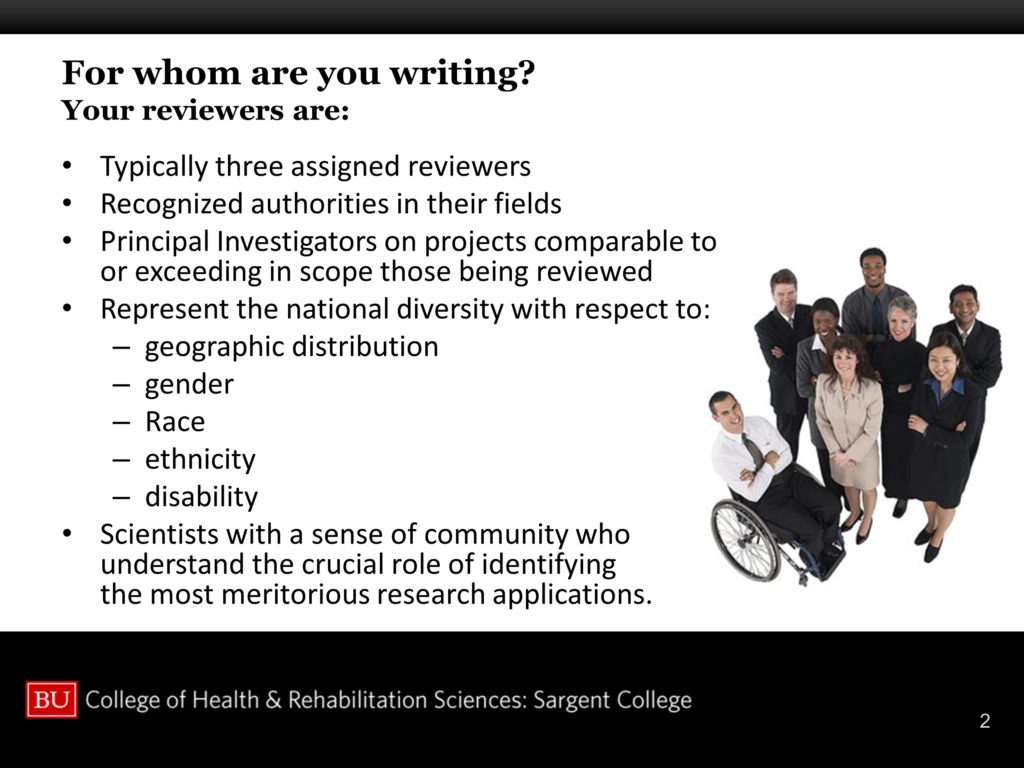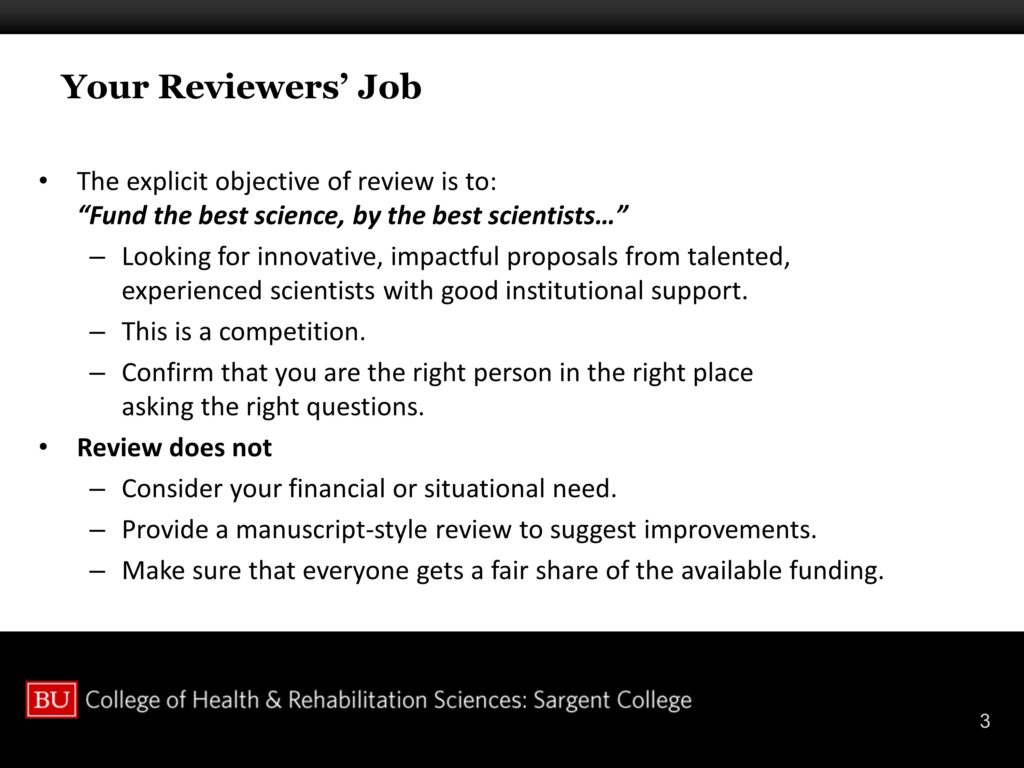The following is a transcript of the presentation video, edited for clarity.
For Whom Are You Writing?
 I thought I’d start by talking to you a little bit about who your reviewers are. A place where people often go wrong, especially new investigators, is they don’t really understand who they’re writing to. To whom it is they are writing.
I thought I’d start by talking to you a little bit about who your reviewers are. A place where people often go wrong, especially new investigators, is they don’t really understand who they’re writing to. To whom it is they are writing.
What’s interesting about study section is that even though there might be 30 or more people in the room, you’re really only writing to three of those people — your three assigned reviewers. Of those assigned reviewers, there will be one that is probably very close to your area, another one that might also be close enough to your area, and one that might not be very close to your area at all.
But they are all experienced scientists. They have applications that are at least of the same funding level as yours. So if you’re applying for R01s, those are going to be R01 holders. They’ll have projects comparable or exceeding those being reviewed in scope, is the way you say that.
The review officer looks at the distribution of panels in terms of the geographic distribution. So people in Seattle don’t get left out all the time. And people in Boston don’t get pulled in every time. On the east coast, it’s so easy to get people to come to study section in DC because it’s a one-day trip. You’re in, you’re out, and nobody even knows you were gone. From Seattle, it’s a three-day trip. So it can be very hard to get geographic distribution, and lately there have been some things they’ve done to try and improve that.
Also, distribution by gender, race, ethnicity, and disability. So there can be a lot of factors that can go into the tensions that determine who your reviewers are. You want it to just be people who are your perfect scientific matches, but there are other things at play.
Mostly, they are scientists with a sense of community who understand the crucial role of identifying the most meritorious research applications. I would add to that that these are the people who are really interested in seeing and driving science. Having something to say about what work gets done. It’s also exciting to read grants and find out about what’s going to be happening in five years. It’s like reading a future version of journals. So it can be really exciting to read these applications.
So that’s who you’re writing to, just these three people. The three people discuss in front of these other 30 people. They discuss these applications. Then they recommend a score and usually, with a few exceptions, usually the rest of the panel says, “Okay. You say 1.3, I say 1.3.” So a lot goes into just these three people. Bear that in mind with the rest of this. You have a very focused, very pointed, determined objective.
Your Reviewers’ Job
 Reviewers are reminded over and over again that their job—and this phrase shows up everywhere—their job is to fund the best science, by the best scientists.
Reviewers are reminded over and over again that their job—and this phrase shows up everywhere—their job is to fund the best science, by the best scientists.
They are not doing all kinds of things that you want them to do.
They are not making sure that everybody gets a chance, that everybody gets a piece of the pie, that there’s some kind of fairness involved. There’s none of that. This is the best science, by the best scientists. These are taxpayer dollars that are going—in the case of NIH—toward the betterment of Americans’ health. In the most innovative, impactful way from experienced scientists working in places where they are getting great support.
This is a flat-out competition. That’s another part of it people try to avoid. But this is a flat-out competition. There will only be a fixed percentage of those applications that will get funded.
Their evaluation is to make sure you are the right person, asking the right question, in the right place. Making sure all of those things match up. It’s not just about the research plan, it’s about the biographical sketch, it’s about institutional support, it’s about the patient flow. Letters of support and things like that are all part of this application.
Reviewers couldn’t care less about your financial need. I actually will never forget, I had an application once from a person who in their introduction to the resubmission described to us their mortgage circumstances. I’m absolutely serious. This has nothing to do with that.
This is not a manuscript-style review. Don’t look for reviewers to make improvements to your application or your idea. Reviewers often can’t help themselves, but that’s not what they’re supposed to do. They’re really supposed to just look at it and go, “This is good. This is not good.” Or, “This is a strength. This is a weakness” is actually how we train them to say it.
They are definitely not trying to make sure everyone gets a fair share of the funding. You will see as times get tougher and tougher the rich are getting richer. The income disparity actually exists as much in research as it does in the rest of our world. Strong labs just are able to be very productive. They attract strong, hard-working people so that attracts more funding. You can argue that that’s a reasonable thing to have happen. It’s not as true in our discipline, but it is true in biomedical sciences generally.
Preparing for Your First NIH Grant: More Videos in This Series
1. Who Is the Target Audience for Your Grant?
2. How Do I Determine an Appropriate Scope, Size, and Topic for My Research Project?
3. Common Challenges and Problems in Constructing Specific Aims
4. Are You Ready to Write Your First NIH Grant? Really?
5. Demystifying the Logistics of the Grant Application Process
6. Identifying Time and Budgetary Commitments for Your Research Project
7. Anatomy of the SF424: A Formula for NIH Research Grants
8. Common Strengths and Weaknesses in Grant Applications.





